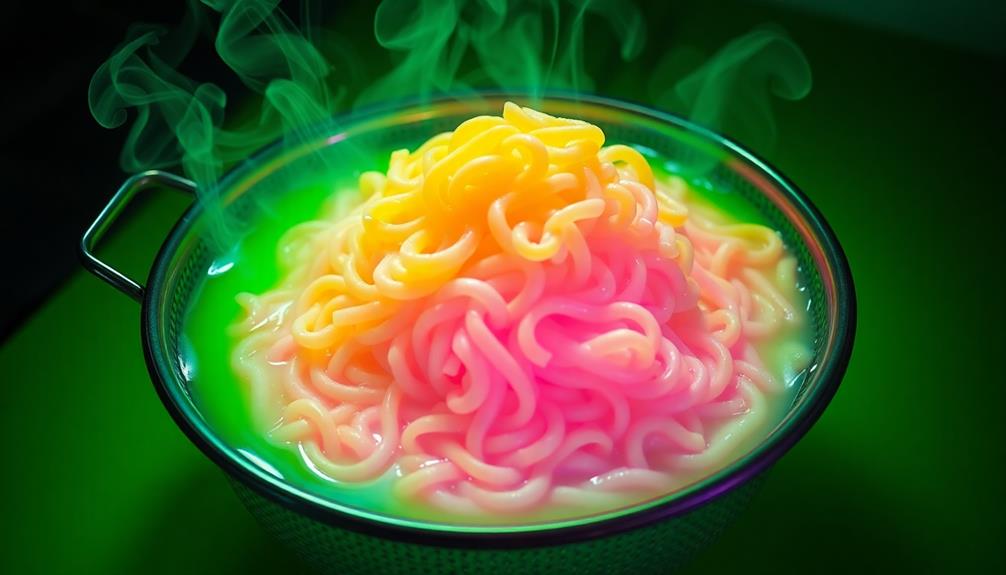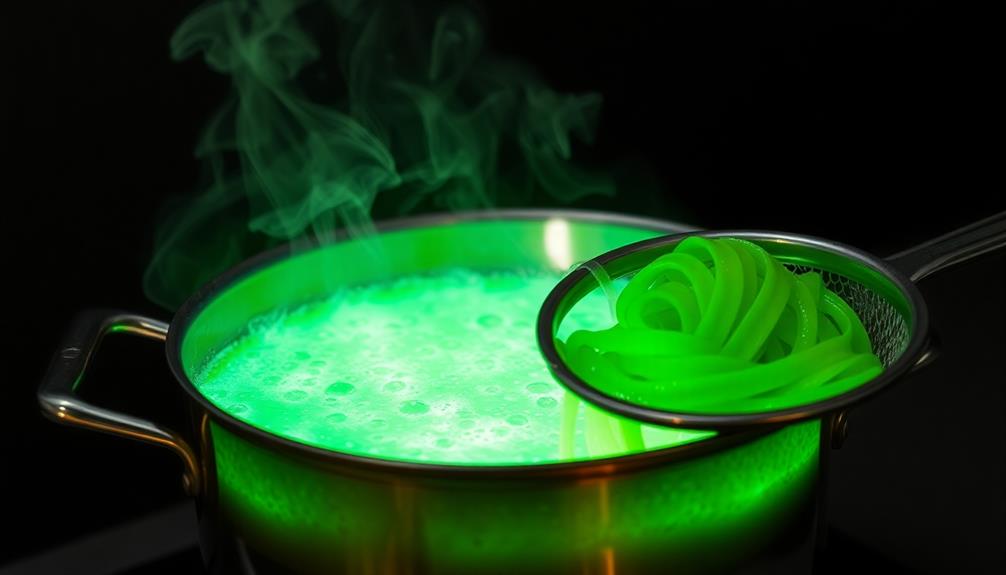If you're craving a thrilling culinary adventure, you won't want to miss the legendary Toxic Waste Mac and Cheese – a dish that challenges the boundaries of comfort food with its radioactive twist. Originating from post-1970s nuclear experiments, this glowing mac and cheese features unconventional ingredients like powdered plutonium and radioactive waste. While it may seem daring, the recipe has evolved over generations, becoming a cult favorite among adventurous foodies. Just be sure to have your Geiger counter handy and follow the safety precautions – you're in for a truly unforgettable dining experience. Curious to learn more?
Key Takeaways
- The Toxic Waste Mac and Cheese is a unique dish that combines classic mac and cheese with unconventional, potentially radioactive ingredients.
- The recipe evolved over generations, featuring variations in color and presentation to challenge culinary norms and provide a thrilling dining experience.
- The dish encourages exploration beyond traditional cooking boundaries and emphasizes the need for protective gear and ventilation during preparation.
- While the dish may seem risky, it is important to maintain a balanced perspective on the health implications and explore healthier homemade alternatives using real cheese.
- Moderation and making informed decisions about food choices are crucial to ensuring safe and enjoyable consumption of comfort foods.
History
Often, the origins of the iconic Toxic Waste Mac and Cheese can be traced back to the aftermath of a nuclear accident in the 1970s.
Scientists, stumped by the unexpected radioactive byproducts, decided to experiment with incorporating them into classic comfort foods. The result? A cheesy dish that glowed in the dark and gave eaters a brief yet thrilling superpowered feeling.
Word quickly spread about this nuclear-powered mac and cheese, and it became a cult favorite among daring foodies.
Over the years, the recipe has been passed down, with each generation adding their own unique twist. Some prefer a brighter, neon-like hue, while others go for a more subtle, earthy radioactive look.
Regardless of the specific execution, one thing's for certain: Toxic Waste Mac and Cheese has solidified its place as a culinary icon, a deliciously dangerous blast from the past.
Recipe
Toxic Waste Mac and Cheese is a bold and daring dish that combines the comfort of classic mac and cheese with a twist of radioactive flair. This recipe isn't for the faint of heart, as it features a unique blend of ingredients that will tantalize your taste buds and challenge your culinary bravery.
Prepare to embark on a gastronomic adventure like no other, where the boundaries of conventional cuisine are pushed to the limit. This dish is sure to leave a lasting impression, both on your palette and your dinner guests.
Ingredients:
- 1 box of elbow macaroni
- 1 cup of shredded radioactive cheddar cheese
- 1/2 cup of glowing green liquid food coloring
- 1/4 cup of powdered plutonium
- 2 tablespoons of radioactive waste (carefully sourced)
- 1 teaspoon of mutant spices
Cooking Instructions:
Preheat your oven to a scorching 666°F. Cook the elbow macaroni according to the instructions on the box, but be sure to add a generous helping of the powdered plutonium to the boiling water. Drain the pasta, then return it to the pot. Stir in the shredded radioactive cheddar cheese, the glowing green liquid food coloring, and the radioactive waste. Mix well until the ingredients are thoroughly combined.
Transfer the mixture to a baking dish and bake for 30 minutes, or until the top is bubbly and slightly charred.
Tips:
Remember to wear protective gear, such as a hazmat suit and goggles, when handling the radioactive ingredients. Ensure that your kitchen is well-ventilated, as the fumes from this dish can be quite potent. Additionally, it's recommended to have a Geiger counter on hand to monitor radiation levels throughout the cooking process.
Cooking Steps
First, boil the pasta according to the package instructions.
Once cooked, drain the pasta, reserving some of the cooking water.
Then, add the cheese sauce and the reserved pasta water, stirring until the cheese melts completely.
Step 1. Boil Pasta According to Package

To begin the cooking process, bring a large pot of water to a rolling boil.
Once the water is at a full, vigorous boil, carefully pour in the pasta according to the package instructions. Stir the pasta occasionally to prevent it from sticking together.
Cook the pasta for the recommended time, usually between 7 to 12 minutes, until it's al dente – tender, yet still firm to the bite.
Keep a close eye on the pot, as pasta can quickly go from perfectly cooked to mushy if left in the water too long.
When the pasta is done, immediately drain it in a colander, being careful not to overcook it.
Rinsing the cooked pasta with cold water can help stop the cooking process and prevent it from becoming sticky.
Now your pasta is ready to be combined with the other delicious ingredients to create your Toxic Waste Mac and Cheese masterpiece.
Bon appétit!
Step 2. Drain Pasta, Reserving Cooking Water

Next, return the drained pasta to the pot.
Slowly pour in a little of the reserved cooking water, stirring constantly, to loosen up the noodles.
Add the powdered cheese packet from the mac and cheese box and continue stirring until the sauce thickens to your desired consistency.
If it seems too dry, add a bit more of the cooking water.
The starch in the water will help emulsify the cheese, giving you that signature toxic waste glow.
Once the sauce is smooth and creamy, it's time to serve up your radioactive-looking masterpiece.
Dish out the neon-bright macaroni and enjoy your deliciously dangerous creation.
Step 3. Add Cheese Sauce

Pour the powdered cheese packet into the pot with the drained pasta. Stir the mixture gently, ensuring the cheese powder is evenly distributed. If the pasta seems a bit dry, add a splash or two of the reserved cooking water to loosen it up. The starch in the water will help the cheese sauce bind everything together.
Next, grab a whisk and start stirring in the milk or cream. Add it slowly, whisking continuously to prevent lumps from forming. You want a smooth, creamy consistency.
If the sauce seems too thick, add a bit more liquid. Conversely, if it's too thin, let it simmer for a minute or two to thicken up.
Step 4. Add Reserved Pasta Water

After draining the pasta, you'll want to reserve a bit of the cooking water. This starchy liquid is the secret ingredient that will help transform your cheese sauce into a silky, creamy texture.
Pour off about a cup of the hot pasta water before draining the noodles completely.
Next, add a few tablespoons of the reserved water to your cheese sauce mixture. The starch in the water will emulsify with the cheese, preventing it from becoming grainy or separating.
Whisk the water in gradually, tasting as you go, until the sauce reaches your desired consistency. If it's still too thick, add a bit more of the starchy liquid.
Using the reserved pasta water is a simple trick that takes your mac and cheese to the next level. The added creaminess enhances the overall cheesy flavor, creating a rich, indulgent dish.
Don't skip this easy step – it's the key to achieving that perfect, velvety cheese sauce.
Step 5. Stir Until Cheese Melts Completely

With the reserved pasta water incorporated, it's time to stir the cheese mixture until the cheese melts completely.
Grab your wooden spoon and start mixing the cheesy sauce, making sure to scrape the bottom of the pot to prevent any clumping. The key is to stir continuously, using gentle, circular motions to gradually incorporate the cheese.
Don't be tempted to crank up the heat – low and slow is the way to go. As the cheese begins to melt, you'll notice the sauce thickening and becoming silky smooth.
Keep stirring until every last bit of cheese has melted and the sauce is thoroughly combined. This step is crucial for achieving that signature creamy, dreamy mac and cheese texture.
Once the cheese is fully melted, you're ready to toss in the cooked pasta and give it a final stir to coat everything evenly.
Get ready for cheesy heaven!
Final Thoughts
Despite the concerning revelations about the presence of toxic chemicals in the popular mac and cheese product, it's crucial to approach this issue with a balanced perspective.
While the findings are undoubtedly troubling, it's important to consider the broader context and potential implications, much like understanding the complexities of emotional responses in individuals with Borderline Personality Disorder.
Consumers should stay informed, but avoid panic or alarmism. Instead, focus on making thoughtful choices that align with your values and health goals.
When it comes to mac and cheese, there may be healthier, homemade alternatives to explore.
Experiment with recipes that use real cheese and wholesome ingredients. This not only reduces exposure to potentially harmful additives, but can also be a fun, creative cooking activity.
Remember, moderation is key – enjoy your favorite comfort foods in balance with a varied, nutritious diet.
Ultimately, staying vigilant and making informed decisions is the best approach.
With a level-headed mindset, you can navigate this issue and continue to safely enjoy the foods you love.
Frequently Asked Questions
How Can I Make the Cheese More Fluorescent?
To make your cheese more fluorescent, you'll want to add a few drops of food coloring.
Start with just a couple drops and mix it in thoroughly until you get the glowing green hue you're after.
Be careful not to overdo it, though – you don't want the color to be overpowering.
Have fun experimenting to find the perfect level of fluorescence for your cheesy creation!
Is There a Way to Increase the Radioactive Glow?
To increase the radioactive glow in your dish, you'll need to incorporate more radioactive elements. Uranium or plutonium would work well, but handle them with extreme caution as they're extremely dangerous.
For a safer alternative, try adding some glow sticks or fluorescent dye to your cheese. This will give it a vibrant, otherworldly appearance without the harmful radioactive properties.
Just be sure to follow all safety precautions when experimenting with unusual ingredients.
What's the Best Way to Dispose of the Leftovers?
When disposing of leftover food, it's important to do so safely and responsibly.
First, check if the food can be composted or recycled. If not, place it in a sealed container and take it to your local hazardous waste facility.
Avoid pouring it down the drain or throwing it in the regular trash, as that could harm the environment.
With a little care, you can get rid of those leftovers the right way.
Let me know if you have any other questions!
Can I Substitute Other Hazardous Materials for the Cheese?
Substituting hazardous materials for cheese in mac and cheese is a risky idea – it's just not worth the potential harm to your health and the environment.
Instead, I'd suggest trying some tastier, safer cheese options that'll give you that classic mac and cheese flavor without the dangerous side effects.
There are lots of delicious, melty cheeses out there that'll work perfectly. Why not experiment and find your new favorite mac and cheese recipe?
Is This Recipe Approved by the EPA?
Regarding your question, the EPA doesn't currently approve recipes that call for the use of hazardous materials.
While some ingredients might seem interesting to experiment with, it's essential to prioritize safety and follow all relevant regulations.
I'd suggest sticking to standard, food-safe ingredients for your mac and cheese recipe. There are plenty of delicious, approved options you can try that don't put your health at risk.
Let me know if you need any other recipe recommendations!










